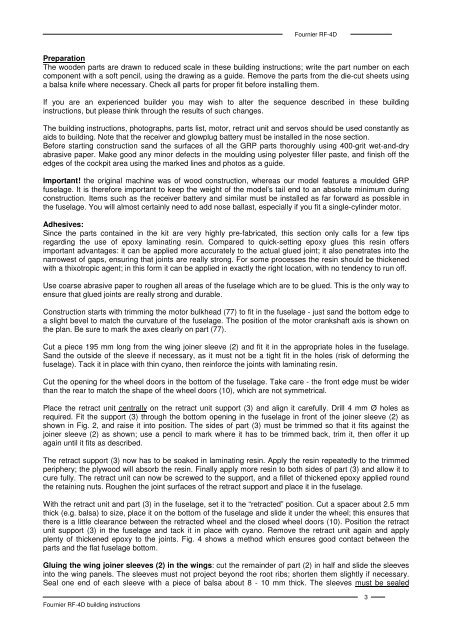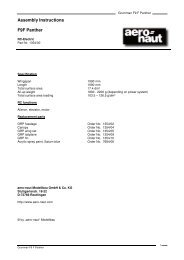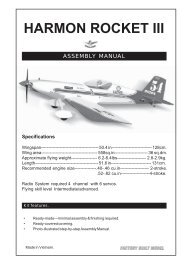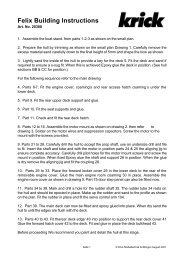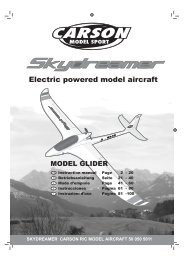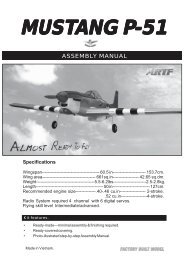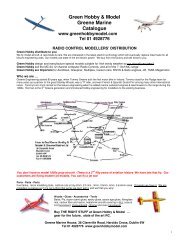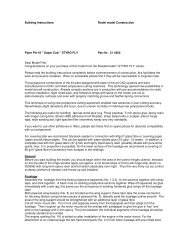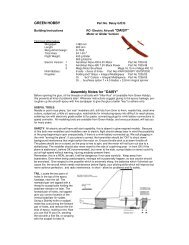Building instructions Fournier RF-4D - Aero-naut
Building instructions Fournier RF-4D - Aero-naut
Building instructions Fournier RF-4D - Aero-naut
You also want an ePaper? Increase the reach of your titles
YUMPU automatically turns print PDFs into web optimized ePapers that Google loves.
<strong>Fournier</strong> <strong>RF</strong>-<strong>4D</strong>PreparationThe wooden parts are drawn to reduced scale in these building <strong>instructions</strong>; write the part number on eachcomponent with a soft pencil, using the drawing as a guide. Remove the parts from the die-cut sheets usinga balsa knife where necessary. Check all parts for proper fit before installing them.If you are an experienced builder you may wish to alter the sequence described in these building<strong>instructions</strong>, but please think through the results of such changes.The building <strong>instructions</strong>, photographs, parts list, motor, retract unit and servos should be used constantly asaids to building. Note that the receiver and glowplug battery must be installed in the nose section.Before starting construction sand the surfaces of all the GRP parts thoroughly using 400-grit wet-and-dryabrasive paper. Make good any minor defects in the moulding using polyester filler paste, and finish off theedges of the cockpit area using the marked lines and photos as a guide.Important! the original machine was of wood construction, whereas our model features a moulded GRPfuselage. It is therefore important to keep the weight of the model’s tail end to an absolute minimum duringconstruction. Items such as the receiver battery and similar must be installed as far forward as possible inthe fuselage. You will almost certainly need to add nose ballast, especially if you fit a single-cylinder motor.Adhesives:Since the parts contained in the kit are very highly pre-fabricated, this section only calls for a few tipsregarding the use of epoxy laminating resin. Compared to quick-setting epoxy glues this resin offersimportant advantages: it can be applied more accurately to the actual glued joint; it also penetrates into thenarrowest of gaps, ensuring that joints are really strong. For some processes the resin should be thickenedwith a thixotropic agent; in this form it can be applied in exactly the right location, with no tendency to run off.Use coarse abrasive paper to roughen all areas of the fuselage which are to be glued. This is the only way toensure that glued joints are really strong and durable.Construction starts with trimming the motor bulkhead (77) to fit in the fuselage - just sand the bottom edge toa slight bevel to match the curvature of the fuselage. The position of the motor crankshaft axis is shown onthe plan. Be sure to mark the axes clearly on part (77).Cut a piece 195 mm long from the wing joiner sleeve (2) and fit it in the appropriate holes in the fuselage.Sand the outside of the sleeve if necessary, as it must not be a tight fit in the holes (risk of deforming thefuselage). Tack it in place with thin cyano, then reinforce the joints with laminating resin.Cut the opening for the wheel doors in the bottom of the fuselage. Take care - the front edge must be widerthan the rear to match the shape of the wheel doors (10), which are not symmetrical.Place the retract unit centrally on the retract unit support (3) and align it carefully. Drill 4 mm Ø holes asrequired. Fit the support (3) through the bottom opening in the fuselage in front of the joiner sleeve (2) asshown in Fig. 2, and raise it into position. The sides of part (3) must be trimmed so that it fits against thejoiner sleeve (2) as shown; use a pencil to mark where it has to be trimmed back, trim it, then offer it upagain until it fits as described.The retract support (3) now has to be soaked in laminating resin. Apply the resin repeatedly to the trimmedperiphery; the plywood will absorb the resin. Finally apply more resin to both sides of part (3) and allow it tocure fully. The retract unit can now be screwed to the support, and a fillet of thickened epoxy applied roundthe retaining nuts. Roughen the joint surfaces of the retract support and place it in the fuselage.With the retract unit and part (3) in the fuselage, set it to the “retracted” position. Cut a spacer about 2.5 mmthick (e.g. balsa) to size, place it on the bottom of the fuselage and slide it under the wheel; this ensures thatthere is a little clearance between the retracted wheel and the closed wheel doors (10). Position the retractunit support (3) in the fuselage and tack it in place with cyano. Remove the retract unit again and applyplenty of thickened epoxy to the joints. Fig. 4 shows a method which ensures good contact between theparts and the flat fuselage bottom.Gluing the wing joiner sleeves (2) in the wings: cut the remainder of part (2) in half and slide the sleevesinto the wing panels. The sleeves must not project beyond the root ribs; shorten them slightly if necessary.Seal one end of each sleeve with a piece of balsa about 8 - 10 mm thick. The sleeves must be sealed<strong>Fournier</strong> <strong>RF</strong>-<strong>4D</strong> building <strong>instructions</strong>3


